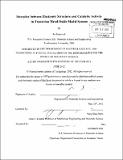Interplay between electronic structure and catalytic activity in transition metal oxide model system
Author(s)
Suntivich, Jin
DownloadFull printable version (17.08Mb)
Other Contributors
Massachusetts Institute of Technology. Dept. of Materials Science and Engineering.
Advisor
Yang Shao-Horn.
Terms of use
Metadata
Show full item recordAbstract
The efficiency of many energy storage and conversion technologies, such as hydrogen fuel cells, rechargeable metal-air batteries, and hydrogen production from water splitting, is limited by the slow kinetics of the oxygen electrochemical reactions. Transition-metal oxides can exhibit high catalytic activity for oxygen electrochemical reactions, which can be used to improve efficiency and cost of these devices. Identifying a catalyst "design principle" that links material properties to the catalytic activity can accelerate the development of highly active, abundant transition metal oxide catalysts fore more efficient, cost-effective energy storage and conversion system. In this thesis, we demonstrate that the oxygen electrocatalytic activity for perovskite transition metal oxide catalysts primarily correlates to the a* orbital ("eg") occupation. We further find that the extent of B-site transition metal-oxygen covalency can serve as a secondary activity descriptor. We hypothesize that this correlation reflects the critical influences of the a* orbital and transition metal-oxygen covalency on the ability of the surface to displace and stabilize oxygen-species on surface transition metals. We further propose that this ability to stabilize oxygen-species reflect as the rate-limiting steps of the oxygen electrochemical reactions on the perovskite oxide surfaces, and thus highlight the importance of electronic structure in controlling the oxide catalytic activity.
Description
Thesis (Sc. D.)--Massachusetts Institute of Technology, Dept. of Materials Science and Engineering, 2012. Cataloged from PDF version of thesis. Includes bibliographical references (p. 109-125).
Date issued
2012Department
Massachusetts Institute of Technology. Department of Materials Science and EngineeringPublisher
Massachusetts Institute of Technology
Keywords
Materials Science and Engineering.